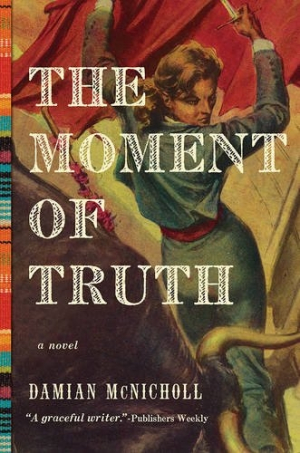
The Moment of Truth
Bullfighting’s place in the world of performative art, as well as its morality, are discussed intelligently.
A young woman with a passion for bullfighting navigates the prejudiced world of the 1950s in this novel of growing up. Enchanted by the sport since attending a fight as a child, Kathleen accepts a deal from a matador in Mexico, leaving behind family and friends in Texas who believe her misguided. Everything appears to be stacked against her. Even when her talent begins to be recognized, her instructor, Fermin, takes all the credit. Throughout Damian McNicholl’s The Moment of Truth, Kathleen learns to take what’s hers and to live life on her own terms.
Alternating perspectives between Kathleen and Fermin add dimension to the plot, but it is Kathleen’s first-person chapters that drive the narrative. Fear, superstition, and a slew of other childish flaws restrict her advancement both professionally and personally; however, her youthful stubbornness ultimately redeems her. She is delivered from these pages as a full human person, three-dimensional and dynamic. A romantic subplot, too, shapes her character, and tensions surrounding the relationship refocus her.
Kathleen’s story rises above typical “feminist” stereotypes: she does not, for example, disguise herself as a man, like Joan of Arc, despite pleas of “The bullring’s no place for you to look like a woman.” She retains her femininity even during the brutality of the fights, proving that a woman can do “a man’s job” without losing any sense of womanhood. The fact that she, as the first famous female matador, is a white American rather than Mexican, and that this novel is authored by a man, deserves notice, though this does not diminish the message.
The story flows through Kathleen’s training and her personal life with an easy, engaging pace. Stylistic choices, especially in the dialogue, bring a sense of place to the novel: there are plenty of “y’alls,” “fixin’s,” and “chiquitas” to go around. Bullfighting’s place in the world of performative art, as well as its morality, are discussed intelligently.
The Moment of Truth follows the hero’s journey story arc, or, in this case, the heroine’s. As Kathleen says more than once, “The bulls don’t discriminate.”
Reviewed by
Aimee Jodoin
Disclosure: This article is not an endorsement, but a review. The publisher of this book provided free copies of the book to have their book reviewed by a professional reviewer. No fee was paid by the publisher for this review. Foreword Reviews only recommends books that we love. Foreword Magazine, Inc. is disclosing this in accordance with the Federal Trade Commission’s 16 CFR, Part 255.
